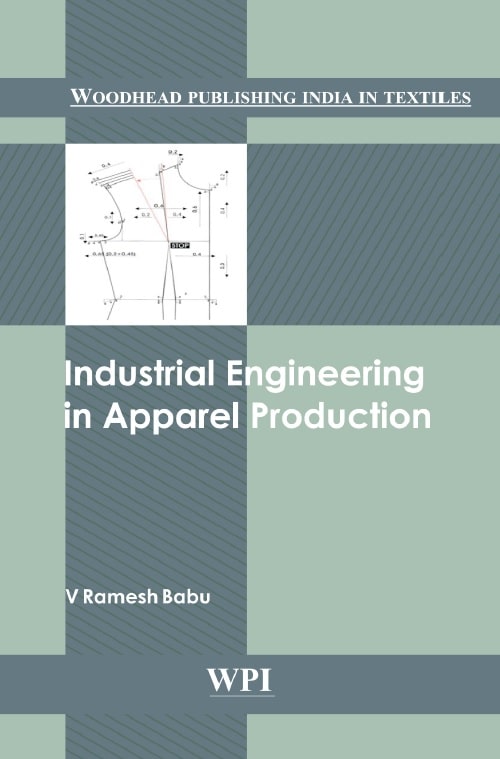
Contents
Preface ix
Acknowledgements xi
1 Concepts of production and productivity 1
1.1 Introduction 1
1.2 Production 2
1.3 Productivity 5
1.4 Standard of living 8
1.5 Productivity measures 11
1.6 References 13
2 Role of apparel engineering 15
2.1 Introduction 15
2.2 Apparel engineering 16
2.3 Methodology 17
2.4 Benefits of engineering 18
2.5 Tools and techniques for apparel engineering 18
2.6 Role of industrial engineer 21
2.7 Pre-production activities of a supervisor 24
2.8 References 28
3 Method analysis 29
3.1 Definition 29
3.2 Recording the method 31
3.3 Operation process chart 33
3.4 Flow process chart 35
3.5 Flow diagram 37
3.6 String diagram 38
3.7 Travel chart (From – To chart) 40
3.8 Multiple activity chart (or) man–machine chart 44
3.9 References 45
4 Motion economy 47
4.1 Principles of motion economy 47
4.2 Two-handed process chart 50
4.3 Micro motion study 52
4.4 Study of method recorded 55
4.5 Methods improvement 60
4.6 References 62
5 Apparel production systems and factory layout 63
5.1 Introduction 63
5.2 Garment production systems 63
5.3 Group system 64
5.4 Progressive bundle synchro straight line system – batch system 66
5.5 Unit production system (UPS) 69
5.6 Quick response sewing system 71
5.7 Layout objectives 72
5.8 Designing the layout 74
5.9 References 77
6 Work measurement 79
6.1 Definition of work measurement 79
6.2 Techniques of work measurement 80
6.3 Time study 87
6.4 Selecting the job 91
6.5 Standard allowed minute (SAM) 96
6.6 Rating factor 100
6.7 Allowances 104
6.8 Other methods to set time standards 108
6.9 References 112
7 Application of IE techniques in garment industry 113
7.1 Capacity study 113
7.3 Operator performance 115
7.4 Follow-ups 117
7.5 Work in process (WIP) 120
7.6 Operation bulletin 122
7.7 References 127
8 Line balancing 129
8.1 Balancing 129
8.2 Steps to balance the line 131
8.3 Initial balance 134
8.4 Balance control (Operating a line) 140
8.5 Efficiency 142
8.6 Cycle checks 143
8.7 Balancing tools 145
8.8 References 151
9 Scientific method of training 153
9.1 SMT (Scientific method of training) 153
9.2 Methodology behind SMT 155
9.3 Selection test 159
9.4 Basic exercise 161
9.5 Paper exercise 162
9.6 Fabric exercise 163
9.7 References 168
10 Industrial engineering in apparel quality control 169
10.1 Introduction 169
10.2 Quality is a multi-dimensional aspect 171
10.3 How to control quality? 172
10.4 How to achieve good quality? 174
10.5 Quality specifications sheet 175
10.6 Quality training 176
10.7 References 179
Index 181
Preface
The garment manufacturing and exporting industry is facing heavy challenges due to various factors including global competition, production costs increase, less productivity/efficiency, labor attrition, etc. In the present scenario we need to give a thought to the emerging situation and go deep into analysis of the situation in a realistic manner. The basic fact that our country has immense strength in human resources itself is the motivating aspect to feel for such an analysis. Our analysis arrives at a view that we need better focus and concentration in identifying the real issues, taking corrective actions suiting to the specific industrial centre or unit, empowering the workers, supervisors, executives and managers by enhancing their knowledge and ability, analyzing orders effectively and decide whether it is viable for the factory, etc. There is a lot of internal correction and openness to knowledge/technology approach that needs to be built into the minds of the facility owners and managers and so also down the line. The facilities have to upgrade as system run, rather than people run. The industrial engineering concept needs to be imparted to the facilities to increase productivity.
This book is wished-for for a broad range of readers, including students, researchers, industrialists and academicians, as well as professionals in the clothing and textile industry. For easy understanding, the text is supplemented by illustrations and photographs wherever possible. Although it is fundamentally a research monograph, it includes considerable industrial standards, techniques and practices. It is, therefore, not only useful for the academia, but also provides a handy reference for professionals in the industry.
The book is divided into 10 chapters, each with specific topic. Chapter 1 deals with the concepts of production and productivity. Chapter 2 confers the role of apparel engineering. Chapter 3 converses the techniques and the standards of method analysis and recoding techniques. Chapter 4 deals with the principle of motion economy and describes the techniques such as two-handed process chart and simo chart. Chapter 5 reviews the various apparel production systems and factory layouts. Chapter 6 presents the work measurement techniques such as work sampling, stop watch procedure and time study in detail. Chapter 7 explains the application of industrial engineering techniques in apparel industry with realistic examples. Chapter 8 deals with the line balancing techniques adopted in the garment industry. Chapter 9 describes the scientific approach of various training techniques imparted to the tailors. Chapter 10 reviews the industrial engineering in quality control.
